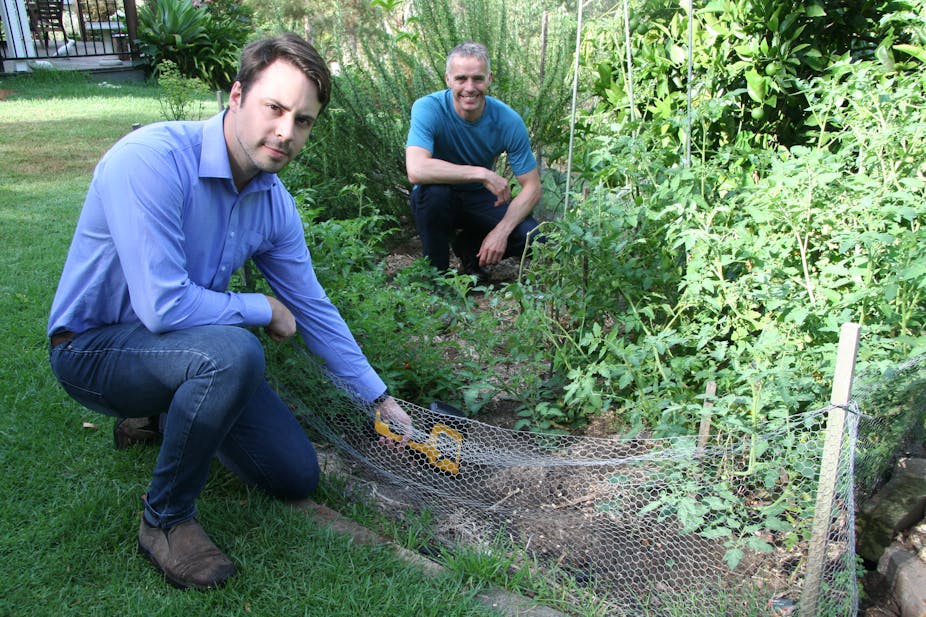In our recent study we found that 40% of 203 Sydney homes we sampled contain lead in garden soil above the Australian health guideline of 300 milligrams per kilogram (mg/kg).
This presents a hazard because soil lead can adhere to or get absorbed into edible plants. An additional pathway of exposure occurs when contaminated soil dust enters homes and is accidentally ingested. Lead is a potent neurotoxin that affects childhood development.
Urban agriculture and VegeSafe
Urban agriculture is becoming more popular across Australia. Almost half (48%) of all households in metropolitan areas are now growing some form of edible produce.
Most lead contamination is a result of the historical use of lead petrol and lead-based paint (now phased out) and previous industrial emissions. Scientists and regulators are well aware of these legacy issues, but the general public remains underinformed about the potential risks.
To help urban gardeners assess contamination risks associated with their garden soils, we started the community science initiative VegeSafe in 2013. This program offers free soil metal screening to participants.
Each participant receives a formal report on their soil metal results and advice about what to do next if soils contain elevated concentrations of metals. We have provided 5,500 free soil metal tests to over 1,300 homes and community gardens (Australia-wide), the largest program and study of its kind in Australia.
What did we find?
As well as the 40% of Sydney gardens containing soil above the 300 mg/kg Australian health guideline, approximately one in seven homes had soils lead levels greater than 1,000 mg/kg. Soil metal concentrations were typically greatest around drip lines.
Soil lead concentrations were greatest in the City of Sydney and former local government areas of Leichhardt Municipal Council and Marrickville Council, which had mean soil lead concentrations of 883 mg/kg, 960 mg/kg and 689 mg/kg, respectively.

Homes with painted exteriors built before 1970 were more likely to have soils contaminated with lead. The highest levels are at homes 80 years or older. This is likely to have been caused by lead-rich paint, which contained up to 50% lead prior to 1970. Lead in paint was reduced to less than 1,000 mg/kg (0.1%) by 1997.
We observed the environmental benefit of the withdrawal of lead from paints and leaded petrol (removed in 2002) in our study. Garden soils at newer homes contain the least lead. Soil lead concentrations decrease with distance from Sydney’s city centre, where there are more old homes and greater density of traffic and industry.

Public health
Lead exposure is especially detrimental for children because their neurological and skeletal systems are developing. Adults are also adversely affected, with studies showing increased blood pressure and hypertension associated with sub-clinical exposures.
Toxicological evidence also shows that exposure reduces semen quality and extends the time to pregnancy. In short, lead is detrimental to all human systems and exposures should be avoided or minimised at all times.
Our study demonstrates lead contamination in garden soils is greater at painted homes than non-painted homes. Many pre-1970 Australian homes still contain paint with up to 50% lead on exterior walls, fences, eves, doors and window frames.
The main risk of exposure arises when lead-based paint deteriorates or is removed improperly. Indeed, many home renovators unwittingly expose themselves and others due to a lack of knowledge of lead hazards.

Reducing exposure
The United States Environmental Protection Agency introduced legislation specifically targeting houses with lead paint to prevent contamination and to minimise avoidable lead exposures.
Unfortunately this regulatory gap has not been filled in Australia. Despite the widespread historic use of lead-based paints and the high proportion of exposure related to it, our data reveals a concerning legacy of soil lead contamination in older suburbs.
We recommend that people residing at or planning to purchase or renovate homes built before 1970 should get their soils and paint tested for lead. Using a qualified lead-abatement decorator in older homes would also help prevent exposure. Where parents and homeowners think they may have caused exposure, their GPs can provide a blood lead test.
Reducing even low-level exposures is critical, as demonstrated by Bruce Lanphear’s “prevention paradox” (see the image below). The graphic illustrates that the most IQ points across a population are lost from low-level lead exposures.

What can gardeners do?
Where non-food-growing soils exceed the Australian soil metal guidelines, we recommend maintaining year-round cover of lawn or mulch to minimise dust generation.
Where metal guidelines are exceeded in food-growing soils, we recommend either replacing existing soil with new, uncontaminated soil, or relocating the food garden to an above-ground vegetable plot (again with new soil).
In this way, gardeners can exercise our motto, which is to carry on gardening knowing their soils are clean.
The VegeSafe program is ongoing for all Australians. Gardeners can send their soil samples to Macquarie University for free soil metal screening of their soil. We do, however, take donations to help sustain our program – so please support your citizen science.

